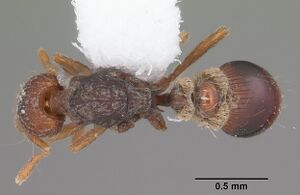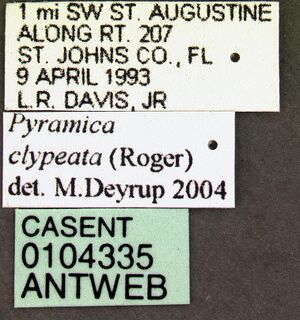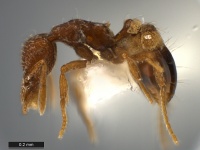Strumigenys clypeata
| Strumigenys clypeata | |
|---|---|

| |
| Scientific classification | |
| Kingdom: | Animalia |
| Phylum: | Arthropoda |
| Class: | Insecta |
| Order: | Hymenoptera |
| Family: | Formicidae |
| Subfamily: | Myrmicinae |
| Tribe: | Attini |
| Genus: | Strumigenys |
| Species group: | clypeata |
| Species: | S. clypeata |
| Binomial name | |
| Strumigenys clypeata Roger, 1863 | |
This species is a relatively common eastern species with a large range. It has been collected in a variety of forest habitats but most often in wet, heavily canopied bottomland forests nesting in moist litter and woody debris (AntWeb, 2021) (Booher, 2021).
Identification
Bolton (2000) - A member of the clypeata group. Within the group clypeata is quickly identified. In full-face view it has an anteriorly broadly rounded glossy (when clean) clypeus, without visible bimargination; the clypeus dorsally has small dense appressed spatulate hairs and laterally has larger spatulate hairs that project as a regular anteriorly curved fringe; the lateral clypeal margins are convex and conceal the outer mandibular margins; it has a small but distinct basal mandibular gap at full closure and relatively fine small teeth, and has a number of flagellate hairs on the head.
Because of the somewhat variable length of the basal mandibular gap this common species is run out twice in the key.
Keys including this Species
- Key to Nearctic Strumigenys (as Pyramica)
- Key to US Strumigenys species
- Key to western Nearctic Strumigenys species
Distribution
USA; widespread in eastern USA from Florida to New York and west to Iowa; in western USA occurs in Oklahoma, Texas, and possibly Kansas. Although reported to occur in northern Mexico (Guzmán-Díaz 2014), the specimen imaged is incorrectly identified. Pilosity, sculpture, and lack of spongiform appendages separate this species from any smithistrumiform species, and I suspect it is Strumigenys margaritae from the visible characters in the image provided. Kansas specimens held at the SEMC were not examined but are left here as possible to that state (Booher, 2021).
Latitudinal Distribution Pattern
Latitudinal Range: 40.817598° to 27.01666667°.
| North Temperate |
North Subtropical |
Tropical | South Subtropical |
South Temperate |
- Source: AntMaps
Distribution based on Regional Taxon Lists
Nearctic Region: United States (type locality).
Distribution based on AntMaps
Distribution based on AntWeb specimens
Check data from AntWeb
Countries Occupied
| Number of countries occupied by this species based on AntWiki Regional Taxon Lists. In general, fewer countries occupied indicates a narrower range, while more countries indicates a more widespread species. |

|
Estimated Abundance
| Relative abundance based on number of AntMaps records per species (this species within the purple bar). Fewer records (to the left) indicates a less abundant/encountered species while more records (to the right) indicates more abundant/encountered species. |

|
Biology
Wesson and Wesson (1939) - A nest of S. clypeata was found in the duff at the base of a small pine tree a few inches from a colony of Myrmica punctiventris. The location was on a dry sandstone bluff in Jackson County, Ohio on which many colonies of Strumigenys pergandei had been found.
Brown (1964) - Buhl, Alabama, 2 nests in rotten chips, swampy river bottom forest. Howardsville, New Jersey, worker in rotten log in oak grove on sand. A worker from Donaldson, Arkansas, in forest debris (H. H. Ross and L. J. Stannard leg.).
Castes
Worker
Images from AntWeb
   
| |
| Worker. Specimen code casent0103000. Photographer April Nobile, uploaded by California Academy of Sciences. | Owned by ABS, Lake Placid, FL, USA. |
Queen
Images from AntWeb
   
| |
| Queen (alate/dealate). Specimen code casent0104335. Photographer April Nobile, uploaded by California Academy of Sciences. | Owned by ABS, Lake Placid, FL, USA. |
Nomenclature
The following information is derived from Barry Bolton's Online Catalogue of the Ants of the World.
- clypeata. Strumigenys clypeata Roger, 1863a: 213 (w.) U.S.A. [Misspelled as clipeata in original description; justified emendation to clypeata by Mayr, 1887: 571.] Emery, 1895c: 328 (q.m.). Combination in S. (Cephaloxys): Emery, 1924d: 325; in S. (Trichoscapa): Smith, M.R., 1947f: 587; Creighton, 1950a: 304; in Smithistruma: Smith, M.R., 1951a: 827; Brown, 1953g: 58; in Pyramica: Bolton, 1999: 1673; in Strumigenys: Baroni Urbani & De Andrade, 2007: 117. See also: Wilson, 1954: 486; Smith, D.R. 1979: 1406; Bolton, 2000: 103.
Unless otherwise noted the text for the remainder of this section is reported from the publication that includes the original description.
Description
Worker
Bolton (2000) - TL 2.0-2.3, HL 0.58-0.64, HW 0.38-0.42, CI 63-68, ML 0.09-0.10, MI 14-17, SL 0.29-0.32, SI 74-80, PW 0.26-0.30, AL 0.54-0.61 (15 measured).
Fully closed mandibles with a small but distinct basal gap between basal tooth and anterior clypeal margin; in general the gap shorter than the length of the basal tooth but subequal in some samples. Anterior clypeal margin broadly evenly rounded. Bimargination of anterior and lateral clypeal margins extremely feebly developed, the lower margin mostly overhung and concealed by the upper. Dorsum of clypeus shining when clean, with dense appressed short-spatulate small hairs. In full-face view lateral clypeal margins shallowly convex and concealing basal portions of outer margins of mandibles. Lateral clypeal margins with a row of anteriorly curved spatulate hairs that stand out from the surface, these hairs larger than those on the clypeal dorsum. Ground-pilosity on head behind clypeus narrowly spatulate to filiform. Dorsolateral margin of head with 2-3 projecting fine flagellate hairs and a pair present on the cephalic dorsum close to the occipital margin. Flagellate hairs present at pronotal humeri, on dorsa of pronotum and mesonotum, on first gastral tergite and on dorsal (outer) surfaces of hind tibia and basitarsus.
Type Material
Bolton (2000) - Syntype workers, U.S.A. Louisiana. [no types known to exist].
References
- Baroni Urbani, C. & De Andrade, M.L. 2007. The ant tribe Dacetini: limits and constituent genera, with descriptions of new species. Annali del Museo Civico di Storia Naturale “G. Doria” 99:1-191.
- Bolton, B. 1999. Ant genera of the tribe Dacetonini (Hymenoptera: Formicidae). Journal of Natural History. 33:1639-1689. (page 1673, Combination in Pyramica)
- Bolton, B. 2000. The ant tribe Dacetini. Memoirs of the American Entomological Institute. 65:1-1028.
- Booher, D.B. 2021. The ant genus Strumigenys Smith, 1860 (Hymenoptera: Formicidae) in western North America north of Mexico. Zootaxa 5061, 201–248 (doi:10.11646/zootaxa.5061.2.1).
- Brown, W. L., Jr. 1953. Revisionary studies in the ant tribe Dacetini. American Midland Naturalist. 50:1-137. (page 58, Combination in Smithistruma, redescriptions of worker, queen, male)
- Chick, L.D., Lessard, J.-P., Dunn, R.R., Sanders, N.J. 2020. The coupled influence of thermal physiology and biotic interactions on the distribution and density of ant species along an elevational gradient. Diversity 12, 456 (doi:10.3390/d12120456).
- Davis, T. 2009. The ants of South Carolina (thesis, Clemson University).
- Emery, C. 1895d. Beiträge zur Kenntniss der nordamerikanischen Ameisenfauna. (Schluss). Zool. Jahrb. Abt. Syst. Geogr. Biol. Tiere 8: 257-360 (page 328, queen, male described)
- Emery, C. 1924f [1922]. Hymenoptera. Fam. Formicidae. Subfam. Myrmicinae. [concl.]. Genera Insectorum 174C: 207-397 (page 325, Combination in S. (Cephaloxys))
- Forel, A. 1886a. Einige Ameisen aus Itajahy (Brasilien). Mitt. Schweiz. Entomol. Ges. 7: 210-217 (page 216, justified emendation of spelling)
- Hill, J.G. 2015. Ants (Hymenoptera: Formicidae) of the Big Thicket Region of Texas. Midsouth Entomologist 8: 24-34.
- Ivanov, K. 2019. The ants of Ohio (Hymenoptera, Formicidae): an updated checklist. Journal of Hymenoptera Research 70: 65–87 (doi:10.3897@jhr.70.35207).
- MacGown, J.A., Booher, D., Richter, H., Wetterer, J.K., Hill, J.G. 2021. An updated list of ants of Alabama (Hymenoptera: Formicidae) with new state records. Transactions of the American Entomological Society 147: 961-981 (doi:10.3157/061.147.0409).
- Roger, J. 1863a. Die neu aufgeführten Gattungen und Arten meines Formiciden-Verzeichnisses nebst Ergänzung einiger früher gegebenen Beschreibungen. Berl. Entomol. Z. 7: 131-214 (page 213, worker described)
- Smith, D. R. 1979. Superfamily Formicoidea. Pp. 1323-1467 in: Krombein, K. V., Hurd, P. D., Smith, D. R., Burks, B. D. (eds.) Catalog of Hymenoptera in America north of Mexico. Volume 2. Apocrita (Aculeata). Washington, D.C.: Smithsonian Institution Pr (page 1406, see also)
- Smith, M. R. 1947f. A generic and subgeneric synopsis of the United States ants, based on the workers. Am. Midl. Nat. 37: 521-647 (page 587, Combination in S. (Trichoscapa))
- Wesson, L. G. and R. G. Wesson. 1939. Notes on Strumigenys from southern Ohio, with descriptions of six new species. Psyche. 46:91-112.
- Wilson, E. O. 1954a [1953]. The ecology of some North American dacetine ants. Ann. Entomol. Soc. Am. 46: 479-495 (page 486, see also)
References based on Global Ant Biodiversity Informatics
- Annotated Ant Species List Ordway-Swisher Biological Station. Downloaded at http://ordway-swisher.ufl.edu/species/os-hymenoptera.htm on 5th Oct 2010.
- Atchison R. A., J. Hulcr, and A. Lucky. 2018. Managed fire frequency significantly influences the litter arthropod community in longleaf pine flatwoods. Environmental Entomology 20(10): 1-11.
- Brown W. L. 1964. The ant genus Smithistruma: a first supplement to the world revision (Hymenoptera: Formicidae). Transactions of the American Entomological Society 89: 183-200.
- Brown W. L., Jr. 1953. Revisionary studies in the ant tribe Dacetini. Am. Midl. Nat. 50: 1-137.
- Campbell K. U., and T. O. Crist. 2017. Ant species assembly in constructed grasslands isstructured at patch and landscape levels. Insect Conservation and Diversity doi: 10.1111/icad.12215
- Colby, D. and D. Prowell. 2006. Ants (Hymenoptera: Formicidae) in Wet Longleaf Pine Savannas in Louisiana. Florida Entomologist 89(2):266-269
- Coovert G. A. 2005. The Ants of Ohio (Hymenoptera: Formicidae). Ohio Biological Survey, Inc. 15(2): 1-207.
- Coovert, G.A. 2005. The Ants of Ohio (Hymenoptera: Formicidae) Ohio Biological Survey Bulletin New Series Volume 15(2):1-196
- Dash S. T. and L. M. Hooper-Bui. 2008. Species diversity of ants (Hymenoptera: Formicidae) in Louisiana. Conservation Biology and Biodiversity. 101: 1056-1066
- Del Toro, I. 2010. PERSONAL COMMUNICATION. MUSEUM RECORDS COLLATED BY ISRAEL DEL TORO
- Deyrup M., C. Johnson, G. C. Wheeler, J. Wheeler. 1989. A preliminary list of the ants of Florida. Florida Entomologist 72: 91-101
- Deyrup, M. 2003. An updated list of Florida ants (Hymenoptera: Formicidae). Florida Entomologist 86(1):43-48.
- Deyrup, M. and J. Trager. 1986. Ants of the Archbold Biological Station, Highlands County, Florida (Hymenoptera: Formicidae). Florida Entomologist 69(1):206-228
- Deyrup, M. and S. Cover. 2009. Dacetine Ants in Southeastern North America (Hymenoptera: Formicidae). Southeastern Naturalist 8(2):191-212
- Dubois, M.B. and W.E. Laberge. 1988. An Annotated list of the ants of Illionois. pages 133-156 in Advances in Myrmecology, J. Trager
- Emery C. 1895. Beiträge zur Kenntniss der nordamerikanischen Ameisenfauna. (Schluss). Zoologische Jahrbücher. Abteilung für Systematik, Geographie und Biologie der Tiere 8: 257-360.
- Forster J.A. 2005. The Ants (hymenoptera: Formicidae) of Alabama. Master of Science, Auburn University. 242 pages.
- Frye J. A., T. Frye, and T. W. Suman. 2014. The ant fauna of inland sand dune communities in Worcester County, Maryland. Northeastern Naturalist, 21(3): 446-471.
- General D. M., and L. C. Thompson. 2011. New Distributional Records of Ants in Arkansas for 2009 and 2010 with Comments on Previous Records. Journal of the Arkansas Academy of Science 65: 166-168.
- General D., and L. Thompson. 2008. Ants of Arkansas Post National Memorial: How and Where Collected. Journal of the Arkansas Academy of Science 62: 52-60.
- General D., and L. Thompson. 2008. New distributional records of ants in Arkansas. Journal of the Arkansas Academy of Science 62: 148-150.
- General D.M. & Thompson L.C. 2008. New Distributional Records of Ants in Arkansas for 2008. Journal of the Arkansas Academy of Science. 63: 182-184
- Guénard B., K. A. Mccaffrey, A. Lucky, and R. R. Dunn. 2012. Ants of North Carolina: an updated list (Hymenoptera: Formicidae). Zootaxa 3552: 1-36.
- Hill J. G., K. S. Summerville, and R. L. Brown. 2008. Habitat Associations of Ant Species (Hymenoptera: Formicidae) in a Heterogeneous Mississippi Landscape. Environ. Entomol. 37(2): 453-463.
- Huong N. T. T., P. V. Sang, and B. T. Viet. 2015. A preliminary study on diversity of ants (Hymenoptera: Formicidae) at Hon Ba Nature Reserve. Environmental Scientific Conference 7: 614-620.
- Ivanov, K. 2019. The ants of Ohio (Hymenoptera, Formicidae): an updated checklist. Journal of Hymenoptera Research 70: 65–87.
- Ivanov K., L. Hightower, S. T. Dash, and J. B. Keiper. 2019. 150 years in the making: first comprehensive list of the ants (Hymenoptera: Formicidae) of Virginia, USA. Zootaxa 4554 (2): 532–560.
- Johnson C. 1986. A north Florida ant fauna (Hymenoptera: Formicidae). Insecta Mundi 1: 243-246
- Lynch J. F. 1988. An annotated checklist and key to the species of ants (Hymenoptera: Formicidae) of the Chesapeake Bay region. The Maryland Naturalist 31: 61-106
- MacGown J. A., J. G. Hill, R. L. Brown, T. L. Schiefer, J. G. Lewis. 2012. Ant diversity at Noxubee National Wildlife Refuge in Oktibbeha, Noxubee, and Winston Counties, Mississippi. Mississippi Agricultural and Forestry Experiment Station Bulletin 1197: 1-30
- MacGown J. A., J. G. Hill, and M. Deyrup. 2009. Ants (Hymenoptera: Formicidae) of the Little Ohoopee River Dunes, Emanuel County, Georgia. J. Entomol. Sci. 44(3): 193-197.
- MacGown J. A., J. G. Hill, and R. L. Brown. 2010. Native and exotic ant in Mississippi state parks. Proceedings: Imported Fire Ant Conference, Charleston, South Carolina, March 24-26, 2008: 74-80.
- MacGown J. A., and R. L. Brown. 2006. Survey of the ants (Hymenoptera: Formicidae) of the Tombigbee National Forest in Mississippi. Journal of the Kansas Entomological Society 79(4):325-340.
- MacGown J.A., Hill J.G. and Skvarla M. 2011. New Records of Ants (Hymenoptera: Formicidae) for Arkansas with a Synopsis of Previous Records. Midsouth Entomologist. 4: 29-38
- MacGown, J.A and J.A. Forster. 2005. A preliminary list of the ants (Hymenoptera: Formicidae) of Alabama, U.S.A. Entomological News 116(2):61-74
- MacGown, J.A. and JV.G. Hill. Ants of the Great Smoky Mountains National Park (Tennessee and North Carolina).
- MacGown, J.A. and R.L. Brown. 2006. Survey of the ants (Hymenoptera: Formicidae) of the Tombigbee National Forest in Mississippi. Journal of the Kansas Entomological Society 79(4):325-340.
- MacGown, J.A., J.G. Hill, R.L. Brown and T.L. 2009. Ant Diversity at Noxubee National Wildlife Refuge in Oktibbeha, Noxubee, and Winston Counties, Mississippi Report #2009-01. Schiefer. 2009.
- MacGown, J.A., R.L. Brown and J.G. Hill. 2005. An Annotated List of the Pyramica (Hymenoptera: Formicidae: Dacetini) of Mississippi. Journal of the Kansas Entomological Societ 78 (3):285-289
- MacKay W. P. and Anderson R. S. 1993. New distributional records for the ant genus Smithistruma (Hymenoptera: Formicidae) in southern United States. The Southwestern Naturalist 38: 388-389
- Macgown J. A., S. Y. Wang, J. G. Hill, and R. J. Whitehouse. 2017. A List of Ants (Hymenoptera: Formicidae) Collected During the 2017 William H. Cross Expedition to the Ouachita Mountains of Arkansas with New State Records. Transactions of the American Entomological Society, 143(4): 735-740.
- O'Keefe S. T., J. L. Cook, T. Dudek, D. F. Wunneburger, M. D. Guzman, R. N. Coulson, and S. B. Vinson. 2000. The Distribution of Texas Ants. The Southwestern Entomologist 22: 1-92.
- Smith M. R. 1931. A revision of the genus Strumigenys of America, north of Mexico, based on a study of the workers (Hymn.: Formicidae). Annals of the Entomological Society of America 24: 686-710.
- Warren, L.O. and E.P. Rouse. 1969. The Ants of Arkansas. Bulletin of the Agricultural Experiment Station 742:1-67
- Wesson L. G., and R. G. Wesson. 1939. Notes on Strumigenys from southern Ohio, with descriptions of six new species. Psyche (Cambridge) 46: 91-112.

